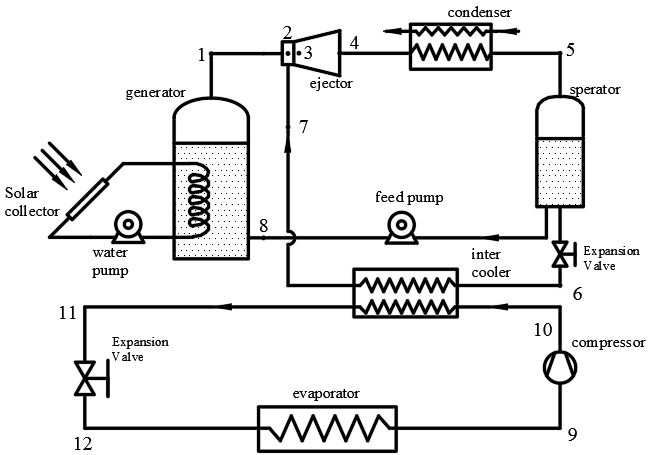Introduction
Hybrid Refrigerant Circuits signify a groundbreaking advancement in the field of heating, ventilation, and air conditioning (HVAC) systems. These systems blend traditional refrigerant-based cooling with secondary fluid loops to achieve unparalleled efficiency, sustainability, and operational flexibility. As industries strive to meet increasing demands for energy-efficient and environmentally friendly technologies, HRCs offer a perfect balance between performance and sustainability. Their design not only reduces refrigerant usage, which directly impacts global warming potential, but also optimizes energy consumption, leading to significant cost savings. By incorporating innovative features such as heat recovery, precise temperature zoning, and simplified maintenance, HRCs are positioned to address critical challenges in both commercial and industrial applications. Furthermore, they align with global efforts to phase out high-GWP refrigerants and transition toward greener alternatives, making them a forward-looking solution for modern HVAC systems.
Key Features of Hybrid Refrigerant Circuits
- Reduced Refrigerant Charge
HRCs use secondary fluid loops (such as water or glycol solutions) to transfer thermal energy, minimizing the amount of refrigerant required in the system. This approach helps reduce the environmental impact by limiting greenhouse gas emissions associated with refrigerants like HFCs. It also ensures compliance with regulations like the Kigali Amendment and F-Gas mandates. - Energy Efficiency
These systems are designed to optimize energy usage through precise control mechanisms. By efficiently transferring heat using secondary fluids, HRCs achieve higher Coefficient of Performance (COP) values, making them ideal for variable load conditions. This leads to substantial energy savings, especially in commercial and industrial applications. - Enhanced Flexibility
HRCs can be adapted to various applications due to their modular design. Whether it’s for cooling, heating, or combined operations, these systems meet diverse requirements across industries, including commercial buildings, healthcare facilities, and industrial plants. - Eco-Friendly Design
The combination of reduced refrigerant use and energy-efficient operation makes HRCs a sustainable choice. By limiting direct refrigerant emissions and reducing energy consumption, they help lower the overall carbon footprint of HVAC and refrigeration systems. - Improved Heat Recovery
HRCs excel in applications requiring simultaneous cooling and heating by recovering heat from one process and utilizing it in another. For instance, heat rejected during refrigeration can be used for space heating or preheating water, maximizing energy utilization. - Simplified Maintenance
By separating the refrigerant circuit from the secondary fluid circuit, the complexity of refrigerant-side maintenance is reduced. This separation lowers the risk of refrigerant leakage, enhances reliability, and simplifies troubleshooting, making maintenance less time-consuming and cost-effective.
Applications of Hybrid Refrigerant Circuits
- Industrial Processes: HRCs provide efficient and reliable cooling for equipment, materials, and processes in industries like manufacturing, chemicals, and pharmaceuticals.
- Data Centers: With precise cooling and reduced environmental impact, HRCs are ideal for maintaining optimal conditions in data centers.
- Commercial Buildings: They offer efficient climate control for offices, malls, and multi-zone environments, ensuring comfort while minimizing energy use.
- Healthcare Facilities: HRCs ensure stable and precise temperature regulation for sensitive medical equipment and environments, such as operating rooms and laboratories.
- Food Storage and Processing: These systems maintain energy-efficient refrigeration in cold storage facilities and food production lines, ensuring product quality.
Future Trends and Innovations in Hybrid Refrigerant Circuits
- Integration with Renewable Energy Sources
Future HRC systems will increasingly integrate with renewable energy sources like solar and wind. This approach reduces dependency on conventional energy, enhancing sustainability and lowering operating costs. - Smart Control Systems
The integration of IoT and AI technologies will enable real-time monitoring and optimization of HRC performance. Smart sensors and predictive analytics will help anticipate maintenance needs, optimize energy consumption, and enhance overall efficiency. - Next-Generation Refrigerants
The development of low-GWP (Global Warming Potential) refrigerants, such as hydrofluoroolefins (HFOs) and natural refrigerants like ammonia and CO2, will make HRCs even more environmentally friendly. - Advanced Materials for Secondary Loops
Innovations in secondary loop materials, such as nanofluids and advanced heat transfer fluids, will improve heat exchange efficiency, reduce energy losses, and enhance system durability. - Compact and Modular Designs
Future HRC systems will feature more compact and modular designs, making them easier to install and scale. This trend will benefit applications with limited space or evolving operational needs. - Enhanced Heat Recovery Technologies
Innovations in heat recovery will enable even more efficient use of waste heat. Future systems will incorporate advanced heat exchangers and thermal storage solutions to maximize energy utilization. - Decarbonization of Industrial Processes
HRCs will play a vital role in industrial decarbonization by replacing conventional HVAC and refrigeration systems with energy-efficient, low-carbon alternatives.
Conclusion
Hybrid Refrigerant Circuits are more than just an innovation—they are a forward-thinking response to the pressing environmental and energy challenges faced by industries today. By significantly reducing refrigerant use and improving energy efficiency, HRCs embody the principles of sustainability without compromising performance. Their versatility across diverse applications, from industrial processes to healthcare and commercial buildings, highlights their adaptability and potential to revolutionize traditional cooling and heating solutions. As advancements in materials, control systems, and refrigerant technologies continue to emerge, the scope and efficiency of HRCs will expand further. In a world increasingly focused on decarbonization and energy conservation, Hybrid Refrigerant Circuits offer a sustainable path forward, enabling industries to meet their operational needs while minimizing environmental impact. They are not just the present but a vital component of the future in sustainable HVAC and refrigeration systems.

